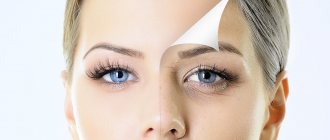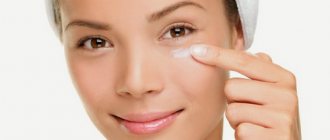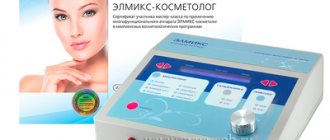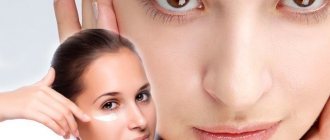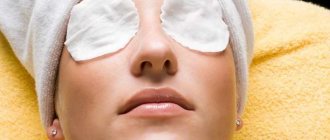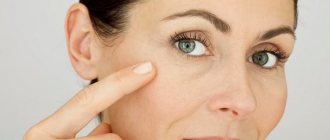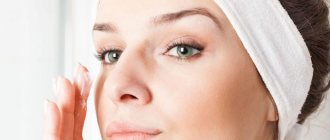Skin folds on the lower and upper eyelids appear due to age-related changes in the epidermis. After 25 years, skin cells and muscle fibers lose their natural elasticity, skin turgor decreases, and soft tissue sagging appears in the periorbital area. Innovative cosmetology methods will help remove skin folds around the eyes, crow's feet and expression wrinkles.
Wrinkle removal using injection method
Procedures for removing folds on the eyelids take place in a cosmetology office under the supervision of a specialist. Active substances or your own fat cells are injected into the periorbital area using a small diameter needle.
After the injection, the epidermis is smoothed due to the replenishment of the intercellular space or blocking of muscle fibers. With other injection techniques, metabolic processes in the tissues of the epidermis are accelerated, and the production of natural collagen and elastin in the skin increases. Injection methods:
Problem: drooping upper eyelids
No one has canceled the force of gravity, however, in addition to gravity, ptosis can be associated with both the loss of tone of the orbicularis muscle and its hypertonicity. And the root of the problem may be a hernia of the upper eyelid. Each case is individual and requires individual consultation with a cosmetologist.
Solution: hardware procedures
Stretched skin of the upper and lower eyelids does not have to be immediately “cut” in a plastic surgery clinic. Radiofrequency thermolysis, performed after anesthesia using special equipment, can quickly, painlessly and without a rehabilitation period tighten the skin and reduce its stretching. More radically, the volume of “excess” skin will be reduced by laser resurfacing procedures - in this case, remember that you cannot do without a rehabilitation period.
Solution: plastic surgery
Oksana Deryabina, dermatocosmetologist, anti-aging medicine doctor, chief physician of New Face Clinic
There are problems that only plastic surgery can help to cope with - for example, hernias of the upper eyelid. Combating these manifestations with the help of hardware and injection techniques is expensive, time-consuming and sometimes useless; moreover, it often has the opposite effect. Why torture yourself if there is blepharoplasty, which is done very quickly, under local anesthesia, and requires a little rehabilitation in one or two weeks? In some cases, only after radical measures does it make sense to profitably work on improving the skin with injections, threads and creams.
Tigran Aleksanyan, MD, plastic surgeon and founder of the Art Plastic clinic
Upper blepharoplasty is indicated for age-related and genetic changes. On the eyelid, excess skin that hangs or approaches the eyelash edge is removed. To get the best result, the doctor makes an incision in the area of the natural fold. If you take this nuance into account, the surgical intervention will remain invisible to others. After the operation, the patient’s appearance improves, swelling and “heavy eyelid” syndrome disappear.
Photo: @doctor_vasilisa
Lower blepharoplasty eliminates cosmetic defects in the lower eyelid area and gives a fresh face, an “open look.” The operation is indicated for severe atrophy of skin tissue in the area of the lower and upper eyelids, deep wrinkles, bags, skin creases.
More often, preference is given to classic blepharoplasty , when skin tissue atrophy is simultaneously corrected and hernias are removed through an incision in the lower eyelid area. For young people, surgeons recommend the transconjunctival method , in which hernias are removed through an incision or puncture in the conjunctival area. The advantage of this technique is the absence of scars on the skin, pain and a short rehabilitation period.
Mesotherapy
Mesotherapy is used for the first signs of aging of the eyelid skin: deep and superficial wrinkles. After the procedure, the skin becomes smooth and elastic, water-lipid metabolism is restored, and the skin color acquires a healthy shade.
Procedure technique: intradermal injections of hyaluronic acid are made into the periorbital area. Along with it, the solution contains amino acids, enzymes, and vitamins. The result of the manipulation: deep wrinkles are smoothed out, the skin on the eyelids is tightened, the face looks younger. The effect of mesotherapy becomes noticeable after 15 – 20 days.
Massage
To perform a massage for sagging skin under the eyes, you will need ice cubes. To prepare them, you need to use a herbal decoction based on chamomile, sage and calendula flowers.
It is necessary to gently wipe the lower eyelids with ice from the outer corner of the eye to the bridge of the nose, without making sudden movements. The duration of the procedure is about 1-2 minutes. After the massage, the skin should dry on its own. After 20 minutes, it is recommended to apply nourishing cream. To get a positive result from a massage, you need to perform the procedure daily.
The procedure is not performed in winter.
Biorevitalization
The technique of implementation of biorevitalization is similar to mesotherapy: hyaluronic acid is injected into the epidermis. The difference is that with mesotherapy the effect does not last long, because in addition to the acid, the solution contains substances that are not independently synthesized at the cellular level. During biorevitalization, a week after the injection, active production of its own hyaluronic acid occurs, due to which the skin of the eyelids is rejuvenated and tightened naturally. The procedure can be performed on girls and women from 25 years of age.
Causes
There are 3 main skin types: normal, oily and dry. It is not surprising that it is with dry skin that changes are most often observed that cause physical and psychological discomfort, in particular peeling, irritation and discoloration. At a young age, such skin looks velvety and soft, but as it ages, in the absence of proper care, its condition rapidly deteriorates, and signs of age-related changes and signs of aging quickly increase.
Dry skin type is most common in women.
A special role in the development of dry eyelids is played by dehydration and delipidation of the stratum corneum of the epidermis, i.e., a decrease in the water content in the epithelium and a decrease in lipid production. But dryness can also be caused by disturbances in the process of keratinization of the epidermis, which leads to structural changes in the cells that form it and disruption of their communication with each other.
Thus, even with normal or oily skin type, the eyelids can become dry. This is called acquired dry skin and may be caused by:
- ultraviolet rays (also causes signs of photoaging);
- wind;
- high temperatures;
- low ambient humidity;
- excessive eyelid skin care using cosmetics containing aggressive ingredients;
- frequent mechanical damage from nails or objects;
- smoking and alcohol abuse;
- insufficient fluid intake during the day;
- malnutrition, leading to the development of vitamin deficiency in the body;
- long-term use of a number of medications, in particular systemic retinoids.
Dry eyelids tend to get worse with age, which is called senile keratosis. This is especially pronounced in women entering premenopause and menopause due to physiological hormonal changes. This is due to the fact that over the years there is a decrease in the production of sebum and sweat, a decrease in lipid production, which leads to the weakness of the protective hydrolipid film.
But dry eyelids can also be caused by pathological changes in the body, both from the skin itself and internal organs and systems. Therefore, it can act as a symptom:
- endocrine disorders, especially diabetes mellitus, hypothyroidism;
- diseases of the nervous system;
- chronic intoxication;
- hypovitaminosis, especially with a lack of vitamins A and C;
- blood diseases;
- hepatitis, liver cirrhosis;
- chronic renal failure;
- dermatological diseases, including contact, atopic dermatitis, ichthyosis, different types of lichen, demodicosis, etc.
In such situations, dryness may worsen after washing, prolonged exposure to the sun or in a room with dry air, where air conditioning is running, exposure to high temperature, etc. In such situations, a feeling of tightness of the skin and itching may also occur.
If the disorder is of an allergic nature, dry eyelids provoke contact with respiratory, food allergens or cosmetics. In the first case, it may be plant pollen, fumes from household chemicals, or animal hair. Contact dermatitis often develops in women as a result of individual intolerance to certain substances contained in decorative cosmetics or creams. Shampoos, conditioners, hair sprays and other similar products can cause similar reactions when they come into contact with the skin of the eyelids.
With atopic dermatitis, dry skin is observed not only on the eyelids, but also on other parts of the body. At the same time, they often cause severe itching, and peeling is also observed.
Therefore, if you have dry eyelids, especially if it is persistent and cannot be eliminated with cosmetics, it is important to consult a dermatologist or dermatocosmetologist. The doctor will not only be able to select the optimal tactics for caring for the delicate skin of the eyelids, but also discover the causes of its dryness and prescribe treatment appropriate to the situation.
Laser therapy
The procedure is carried out under local anesthesia: an analgesic cream is applied to the eyelid area. Resurfacing the skin around the eyes with a laser beam removes the upper layer of the dermis to a depth of 130 microns. As a result, after several procedures, the epidermis is completely cleared of the outer layer of cells, and the production of new cellular structures at the level of the basal layer is activated. Laser wrinkle removal technology is carried out at the site of formation of facial folds and age-related changes in the skin of the eyelids.
Clinical manifestations of crow's feet
Specialists from the American Society for Dermatologic Surgery (ASDS) divide wrinkles around the eyes into 2 types:
- Dynamic - occur when the underlying facial muscles move. They appear during a smile, frowning of the eyebrows, “squinting” the gaze to the side and disappear with a neutral facial expression.
- Static - formed as a result of active facial expressions against the background of age-related changes and photodamage to the skin. Visible all the time, even during sleep.
Employees of two universities - Sao Paulo and Santo Amaro - in their scientific work proposed a classification of periorbital wrinkles, which they recommend using to select treatment tactics for patients ( Fig. 1 ):
- Type I - wrinkles extending from the outer edge of the eye to the eyebrow and zygomatic process.
- Type II - wrinkles extending from the outer edge of the eye to the zygomatic process.
- Type III - single wrinkles limited to the outer edge of the eye.
In addition, there is the Fitzpatrick classification ( Table 1 ) and the 5-point Wrinkle Severity Scale ( Fig. 2 ) - they can also be used to assess the degree of changes in the periorbital zone and select a therapeutic approach.
Table 1. Fitzpatrick classification of periorbital wrinkles
| Class | Points | Expression of wrinkles | Degree of elastosis |
| I | 1–3 | Fine wrinkles | Mild - slight changes in skin texture with visible lines |
| II | 4–6 | Fine to moderate wrinkles | Moderate - clear signs of elastosis, papules, some yellowing of the skin and dyschromia |
| III | 7–9 | Moderate to deep wrinkles with sagging skin | Severe - multiple papules merging with each other; thinned yellow skin, diamond-shaped skin of the neck (cutis rhomboidalis nuchae) |
Rice. 1. Types of periorbital wrinkles (Tamura BM, Odo MY Classification of periorbital wrinkles and treatment with botulinum toxin type A. Surg Cosmet Dermatol 2011; 3(2): 129)
https://www.surgicalcosmetic.org.br
Rice. 2. Diagnosis of wrinkles around the eyes using a 5-point Wrinkle Severity Scale: 0 - no wrinkles, 1 - superficial wrinkles, 2 - fine wrinkles, 3 - medium wrinkles, 4 - deep, clearly visible wrinkles, 5 - very deep wrinkles, furrows ( Lemperle G., Holmes RE, Cohen SR, Lemperle SM A classification of facial wrinkles. Plast Reconstr Surg 2001; 108: 1751–1752)
https://pdfs.semanticscholar.org
Photorejuvenation
The technique for removing visual defects on the skin around the eyes is based on the use of a light beam of a certain frequency. A light-conducting gel is applied to the periorbital area, after which the eyelid skin is treated with short light flashes. The photorejuvenation procedure is not suitable for women with dark skin. The method of removing wrinkles using a light beam has a long-lasting effect - the skin of the eyelids remains elastic and taut for three years.
Among the classic cosmetic products, one cannot fail to mention chemical peeling.
Recommendations for thin facial skin
It is very important to properly care for your facial skin every day, so you should follow certain expert advice:
- do not use ordinary soap, it is better to take special milk or gel;
- do not go to bed with makeup on your face;
- regularly use masks and creams;
- the products should not contain aggressive, alcohol-containing components;
- remove salty, fried, spicy foods from the diet, and add more nuts, vegetables, fruits;
- do not perform aromatherapy, do not make herbal compresses, do not use cosmetic ice;
- Do not stay in the sun for too long, do bath procedures, or visit the sauna;
- sleep enough time so that cells can renew and recover;
- control your facial expressions, try not to wrinkle your forehead or squint your eyes;
- drink plenty of water;
- use sunscreen;
- If you decide to do peeling, then use exfoliating microgranules of artificial origin. They will injure the skin less.
Chemical peeling
The essence of the chemical peeling procedure: organic acid is applied to the skin around the eyes, dissolving keratinized particles of the epidermis. Due to the active components of the acid, active growth of cells in the basal layer of the skin begins, metabolic processes at the cellular level are stimulated, and fibroblasts are produced. As a result, the dermis layer thickens, the skin is saturated with moisture, and protective functions are enhanced, preventing the removal of fluid from the intercellular space. Gentle organic acids are used to carry out the procedure. The effect of the procedure lasts about two months. Then it is recommended to repeat the chemical peeling.
How to choose a cream for wrinkles around the eyes
We are forced to inform you: there is no universal miracle remedy for wrinkles around the eyes that is suitable for absolutely everyone. What should you consider when choosing an anti-aging product for home use?
- Age and age-related needs of the skin , which were not compensated for and ultimately caused the appearance of wrinkles.
- Individual skin characteristics and bad habits : frequent tanning, smoking, excessive consumption of sweets, sedentary lifestyle, etc. This affects the condition of the skin and requires the use of certain active substances to eliminate negative consequences. The ingredients are listed below.
- Type of wrinkles: There are two types of wrinkles - expression and static.
Some manufacturers initially indicate on the packaging of products for wrinkles around the eyes the age for which the cream is intended. This is not true, because wrinkles do NOT appear at a certain age for everyone - the reasons for the appearance of wrinkles around the eyes are completely different for everyone.
Everything is individual, but there are trends in the formation of wrinkles during periods of age - read below.
Modern professional products do not indicate the age of a particular product; this is typical for mass-market products.
